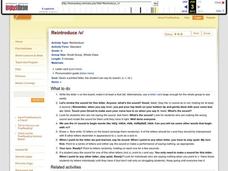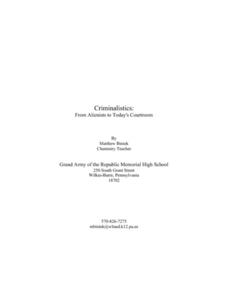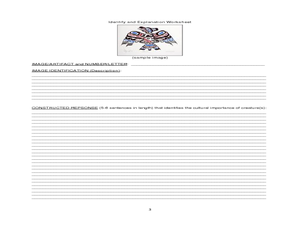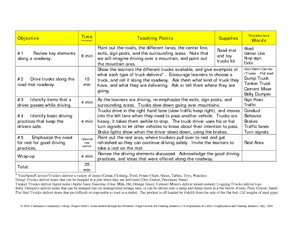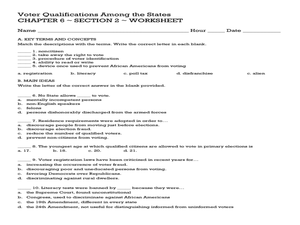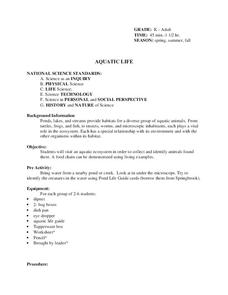Curated OER
Tree Hunt
Students identify the common trees of Iowa and make observations while creating a key. In this tree hunt lesson, students write a letter to the Iowa Department of Natural Resources to receive a pamphlet of Common Trees of Iowa. Students...
Curated OER
ABC Scavenger Map
Students explore phonetics by participating in a class game. In this alphabet sounds lesson plan, students collaborate in a ABC's activity where they identify a random letter, the sound it makes, and place it in it's correct spot on a...
Curated OER
Leaf Patterns
First graders explore the existence of patterns in everyday items. In this science and math integrated lesson, 1st graders match leaves with a name word card and organize them into four patterns. This lesson includes a reading of And the...
Curated OER
Organizing Writing/Composing a First Draft
Seventh graders access an organizer from an earlier instructional activity and transition sentences to begin a new essay. In this organization and composing instructional activity, 7th graders work in small groups to create a draft...
Curated OER
Gandhi's "Good Life"
Eleventh graders use a Gandhian lens to analyze critically materialism in a capitalist society. In this Gandhian philosophy lesson, 11th graders cultivate awareness, explore materialism and sustainability, examine the idea of 'what is...
Curated OER
Reintroduce /V/
Students study letters. In this letter identification and pronunciation lesson, students practice recognizing and saying the letter "v." They work as a group to actively participate in various drills their teacher presents. This lesson...
Curated OER
ESL Holiday Lessons: World Down Syndrome Day
In this language skills worksheet, students read an article about World Down Syndrome Day. Students respond to 6 matching questions, 29 fill in the blank questions, 30 multiple choice questions, 12 word scramble ...
Curated OER
Identifying Triangles
Sixth graders identify and define a variety of triangles. For this identification of triangles lesson, 6th graders draw examples of each triangle on a whiteboard, then complete a worksheet.
Curated OER
Watch the Birdie
Students complete a six-week unit on North American birds. They conduct research, develop fact sheets, create labeled bird drawings, write a dictionary of bird vocabulary words, create a Concentration game, and observe birds in their...
Curated OER
Our Forest is Changing
Students read a story and solve a problem about an unhealthy population of trees. In this forest lesson students study tree disease and then research it online and present what they found.
Curated OER
Managing Multiple Roles
Students identify the roles balanced in family and career activities. In this family and career balance lesson, students identify the roles each family member has and discuss problems problems they see in their own families. Students...
Curated OER
Science: Criminalistics - A New Look at Crime
Students examine the world of forensic science, focusing on fingerprint analysis. In the lesson plan, they implement a method by which fingerprints of class members are categorized and identified. Elementary students study...
Curated OER
Who's New in the Deep Sea?
Students examine the methods and technology that scientists use to study the deep sea and other remote environments. In this ocean habitats lesson students make observations about organisms from video clips, generate questions and...
Curated OER
Stories Behind Pacific Northwest First Nations' Images
Students investigate Canadian culture by examining mascots of the 2010 Olympics. In this Canadian history instructional activity, students read a Vancouver Olympics guide to identify three Canadian mascots and their importance to...
Curated OER
Hopi Agriculture
Pupils discuss the farming practices of the past and present of the Hopi people and discuss the importance of corn. In this Hopi agriculture lesson plan, students also plant their own seeds of corn.
Curated OER
Angle Action
Sixth graders investigate the concept of an angle. They classify an angle according to its type. The lesson has students practice with acute, right, and obtuse angles. A unique part is when telling time using clock hands is related to...
Curated OER
ESL Verbs- What Verb Does This Picture Represent?
In this ESL verb identification multiple choice activity, students examine a black and white clip art picture,. They choose between 4 verbs to find the one that best describes the picture. They complete 8 examples.
Curated OER
ESL What are They Doing? Worksheet
For this ESL verb identification worksheet, students look as small black and white pictures of people doing different things. They answer questions based on the pictures such as "What is he doing?"
Curated OER
My Multicultural Self
Students examine the concept of multiculturalism. In this Teaching Tolerance lesson plan, students consider their self concepts and world views as they participate in an activity that requires them to describe themselves as well as major...
Curated OER
Using Your Senses
Students use their senses to make observations. In this senses lesson plan, students investigate unknown substances by using their senses for observations. Students identify the number of the substances used, the color, the odor, the...
Curated OER
Money: Demonstrating Coin Value up to $1.00
Learners examine coin values up to $1.00 using paper coins. In this coin value lesson, students compare and contrast various coins to aid in identification, sort coins from smallest to largest, and match an equal number of pennies to...
Curated OER
Trucks on the Roadway
Young scholars explore trucks. In this truck and road safety lesson, students identify different types of trucks and define traffic and truck vocabulary. Young scholars manipulate toy trucks on a road floor mat.
Curated OER
Voter Qualifications Among the States
Twelfth graders research the voting qualifications for each state. In this American Government lesson, 12th graders complete a worksheet on the main ideas they have researched.
Curated OER
Aquatic Life
Students explore aquatic life. In this science lesson, students visit an aquatic ecosystem and collect animals found there. Students create a food chain for the aquatic ecosystem.





